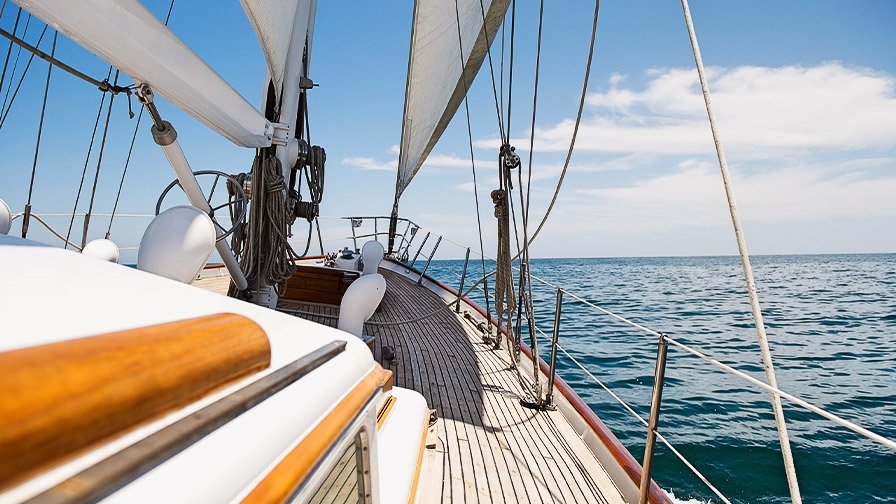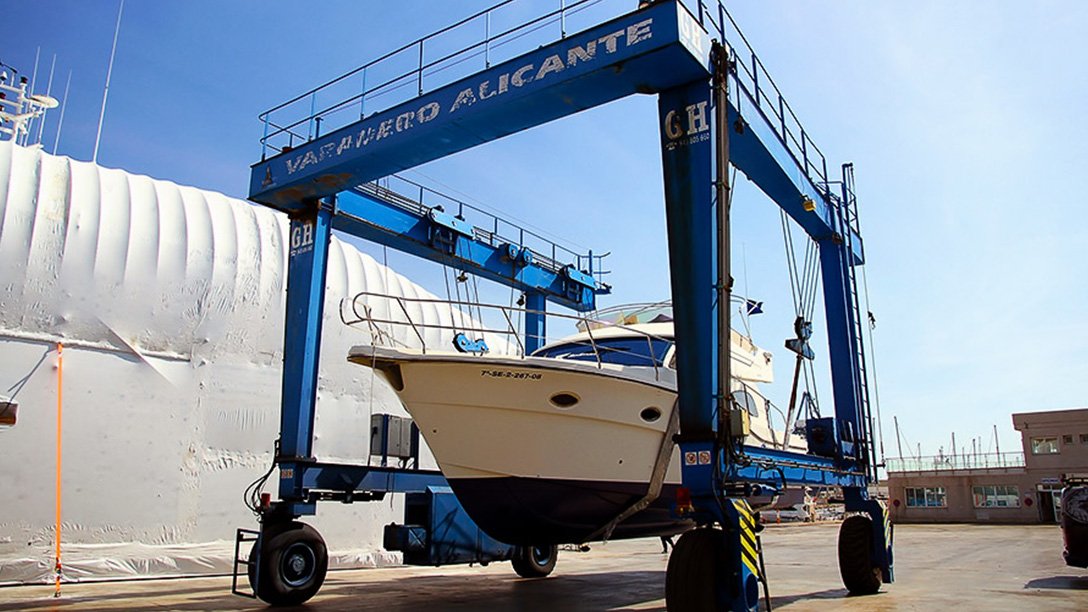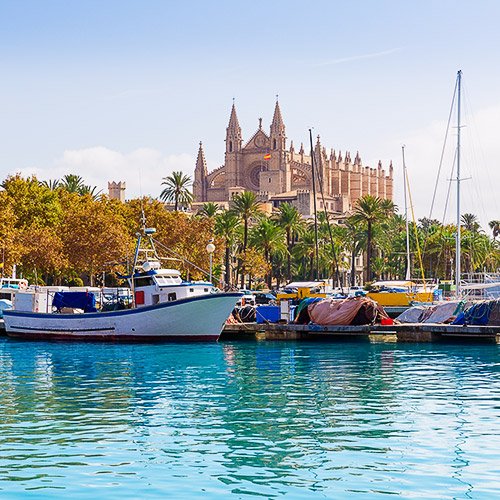This being said, it’s essential to keep a good maintenance of your sailboat or catamaran, beyond a visual inspection of the exterior, especially after chartering it numerous times during summer season.
In this article, we will help you with some basic maintenance tips for keeping the boat exterior in top shape, not just to show its beauty, but also for other critical reasons.
- A clean boat performs better. For example, a dirty hull with vegetation on it is increasing the drag, and of course the fuel consumption by 20 –40 %.
- A clean boat preserves the structure of the boat by keeping the finish in good shape. Keep in mind that is quite costly to remove the scratches and abrasions made by salty water and its erosion effect.
Tip: It’s important to protect the environment, so if you are using cleaning products that can pollute the seas, consider cleaning the boat out of the water.
Below, we’ll discuss about 4 important elements you should not neglect, instead they should be treated with high responsibility.
- Fiberglass
- Canvas
- Upholstery
- Woodwork
1. Fiberglas
Owning a fiberglass sailboat or catamaran, most probably you have gelcoat maintenance to contend with, both on deck and hull sides. Fiberglass and gelcoat, need regularly cleaning, polishing and waxing, for both protective purposes and also for the good looks. Nobody likes a dull and chalky fiberglass hull, so all the above will prevent corrosion and oxidation.
You can see from far distance that Gelcoat poorly maintained, it’s usually chalky and gives the boat the “old” looks, but with the proper compounds and hard work the faded gelcoat can be brought back to life.
If your gelcoat is in good condition, the boat will be sure to shine in the harbour and will always be appreciated by the people renting your boat, so it’s essential to spend time maintaining it throughout the course of the charter season.
Essential gelcoat maintenance is about waxing and/or polishing. Waxes are designed to protect and seal gelcoats, with a coating that repels salt water, dust and the harmful UV. Polishes, on the other hand, generally contain a cutting agent to remove oxidation and corrosion from the gelcoat and make the boat shine. Other products, called cleaner-waxes, contain both a polish and a wax. For boat owners a marine wax needs to have two important qualities: long-lasting and glossy, long-lasting because the boat will be out of the water for a long time and glossy because it makes it very attractive to rent.
Witch one is the best? Depends on many factors, however we recommend the following:
- Meguiar’s M5616 Marine/RV Pure Wax Carnauba Blend, 16 Fluid Ounces, provides durable high-gloss protection for all fiberglass gel coat marine and RV surfaces.
- Boater's EDGE Cleaner Wax, is formulated specifically to remove oxidation and hazing from fiberglass, metal and painted surfaces. The specially engineered polymers seal the restored finish to keep it looking its best while providing unmatched protection against UV rays and a deep, long-lasting gloss.
- 3M Marine Ultra Performance Paste Wax (09030), formulated for enhancing and protecting fiberglass, gelcoats and painted aluminium, it features 3M polymer technology that combines durable, clear acrylic with the soil release and water beading properties of silicone.
- 3M Scotchgard Marine Liquid Wax, easy to apply, maintains an exceptional gloss, especially when used with other 3M boat cleaners and restorers.

Fiberglass boat, high glossy coating
capetanos.com2. Canvas
When we say “canvas” we refer to Bimini tops, boat and sail covers, line pockets and any other cockpit enclosures made by different fabrics that need also good maintenance to preserve them in top condition and to look good for a larger period of time. In the same category we include also the clear polyvinyl chloride parts – PVC – known as “Eisenglass” and “Strataglass”, used to create see through panels incorporated in marine canvas.
Keeping canvas clean is the essential thing to do, however, you shouldn’t wash or dry your canvas in a household washing machine and/ or dryer, because you will ruin the fabric very quickly, leading to buying a new one. Instead, the approach is to use a light brush, mild soap and fresh water to remove salt, dirt, or any other corrosive materials. Doing so, will keep the fabric’s UV and waterproofing components protected and also prevents mildew from taking up residence in the fabric’s weave. If your marine canvas has lost some of its waterproof qualities, consider treating it with a product such as 303 High Tech Fabric Guard.
Another important part is the maintenance of clear PVC parts used to create windows in enclosures, covers, or Bimini tops. These components are raising issues if they are not treated with the correct products, that can cause more damage rather than being useful. Whether you have Eisenglass, Strataglass, or some other PVC material in your canvas, never clean them with an ammonia-based product. The ammonia will break down the plastic, yellow it, and make it brittle over time. Instead, use a quality spray polish designed specifically for use with clear PVC, for example: 40934 210 Plastic Cleaner/Polish or Sumner Laboratories (23304) 210 Plastic Cleaner/Polish.
Zippers and snaps that hold everything together need also regular maintenance and they should be lubricated at least once a year with a lubricant specifically designed for them.

Top shape Bimini
capetanos.com3. Upholstery
The most common fabric used for exterior seating and furniture components is vinyl, being a tough and extremely durable material, but not maintaining it properly and using the wrong cleaners can ruin it. Routine cleaning can be done with a sponge and a bucket of mild, soapy water, followed by thorough rinsing. Strong cleaners that contain bleach or ammonia will definitely shorten the lifecycle of the item. You shouldn’t take into consideration the immediate and pleasing results, because these chemicals will break down and ruin the vinyl over time.
The easiest way to make vinyl last longer is to keep it covered or stowed away, when not using, or renting the boat. Most probably you have exterior cushions that can be detached, so you should store them in a locker or belowdecks at the end of the day or charter period. Permanently exposed vinyl fixtures can also be protected with canvas covers, because the protection they provide is well worth it on the long run.
Many high-tech fabrics with all sorts of textures and comfort features have come on the market over the last years. If you are uncertain as to how you should properly maintain any exterior fabric on your boat, make sure you consult with the manufacturer before proceeding, because the use of a wrong cleaner or protectant can prove to be a costly mistake.
We recommend the following cleaners:
- Meguiars Gold Class Leather Cleaner & Conditioner Leather Care, cleans and cares soft, fine leather without harmful or harsh solvents to use.
- 303 Marine UV Protectant, the formula provides superior UV protection for any rubber, finished leather, plastic, vinyl, eisenglass, PVC, gel coat & fiberglass surfaces.
- 3M Marine Vinyl Cleaner and Restorer, good product used by many boat owners.

Vinyl Upholstery Cleaning
capetanos.com4. Woodwork
Many sailboats and catamarans have some woodwork to take care of, including handrails, toe-rails, cap-rails, stairs and decking.
Most of them are made of teak, a durable tropical hardwood, very resistant to elements. Even being exposed to sun, teak will grey out and last for years, however it still needs occasional cleaning and maintaining, especially on a charter boat.
The easiest thing you can do is to simply leave the uncoated teak to develop a silvery grey patina, but even uncoated teak deserves a good cleaning at least once a season, otherwise you will likely find black mildew ruining that patina over wintertime. There are lots of teak cleaners promising many different miracle results, but you have to choose the mildest one that will do the right job for your expectations. Many boat owners like powder-based cleaners containing oxalic acid, that can step up the aggressiveness of the cleaners based on your teak’s filth factor, but we do recommend trying to stay away from the two-part cleaning systems you’ll find in many marine supply shops, because they are not just harsh on wood, but any other surfaces they drip onto.
If you want to clean the woodwork by yourself, the most important thing to remember is never to scrub the teak with the grain. Doing this will remove the softer pulpwood between the grain and create ugly ridges in your wood. Instead, you can use a soft bristle brush or soft-grade pad and go across the grain until the wood is clean. Once the wood is clean, an occasional light washing with mild soap and a soft brush should keep things looking brand new.
Some other boat owners prefer the distinguished, rich look of a boat with wood that’s been treated with varnish, oil or sealers. While there’s a lot of man hours involved in a full project of this sort, properly applied teak coatings such as varnish generally only need reapplication once a year in northern latitudes, and twice a season south.
There are many high ranked products for treating teak surfaces, and you can find also kits, that include everything you need to clean, restore and protect the teak, like Star Brite Premium Teak Care Kit.

Teak cleaning and maintenance
capetanos.comProper boat maintenance will not just keep your vessel running better and longer, but it will also be in high demand by persons wanting to rent a boat. Everyone who wants to charter a boat, desires to feel comfortable and safe on board of your ship and the tip top looks of it will surely contribute to an amazing sailing experience.




